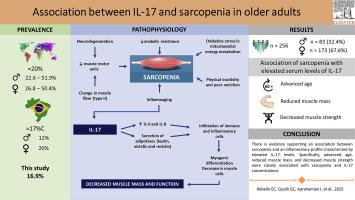Association between IL-17 and sarcopenia in older adults
引用次数: 0
Abstract
Background
Chronic low-grade inflammation has been implicated as a potential contributor to sarcopenia, but the specific inflammatory mediators involved remain under investigation. This study explores the association between serum interleukin-17 levels and sarcopenia in older outpatients without pre-existing inflammatory or autoimmune diseases.
Methods
A cross-sectional study was conducted using data from the MiMiCS-FRAIL cohort. Sarcopenia was defined according to the European Working Group on Sarcopenia in Older People 2 criteria. IL-17 plasma levels were measured using enzyme-linked immunosorbent assay (ELISA). A multivariate binary logistic regression model was used to assess the association between sarcopenia and IL-17 levels.
Results
A total of 255 older adults aged ≥60 years (67.6 % women) were included, with a mean age of 70.8 ± 7.3 years. The prevalence of sarcopenia was 16.9 %. Advanced age (OR = 4.26; 95 % CI: 1.75–10.41; p = 0.001) was significantly associated with sarcopenia. In the fully adjusted model, IL-17 (log-transformed) remained significantly associated with sarcopenia (OR = 1.74; 95 % CI: 1.11–2.74; p = 0.017). Age (OR = 1.10; 95 % CI: 1.03–1.17; p = 0.003) and BMI (OR = 0.69; 95 % CI: 0.60–0.79; p < 0.001) were also associated. IL-6, TNF-α, number of medications, sex, and cognitive score were not statistically significant.
Conclusions
Elevated IL-17 levels were associated with higher odds of sarcopenia among older adults. These findings suggest that IL-17 may serve as a potential biomarker for sarcopenia, although further longitudinal studies are needed to elucidate its causal role.

IL-17与老年人肌肉减少症的关系
慢性低度炎症已被认为是肌肉减少症的潜在诱因,但具体的炎症介质仍在研究中。本研究探讨无炎症或自身免疫性疾病的老年门诊患者血清白细胞介素-17水平与肌肉减少症之间的关系。方法采用来自mimics -虚弱队列的数据进行横断面研究。肌少症的定义是根据欧洲老年人肌少症工作组2的标准。采用酶联免疫吸附试验(ELISA)测定血浆IL-17水平。采用多元二元logistic回归模型评估肌肉减少症与IL-17水平之间的关系。结果共纳入255例60岁以上老年人,其中女性占67.6%,平均年龄70.8±7.3岁。肌肉减少症患病率为16.9%。高龄(OR = 4.26; 95% CI: 1.75-10.41; p = 0.001)与肌肉减少症显著相关。在完全调整的模型中,IL-17(对数转换)仍然与肌肉减少症显著相关(OR = 1.74; 95% CI: 1.11-2.74; p = 0.017)。年龄(OR = 1.10; 95% CI: 1.03-1.17; p = 0.003)和BMI (OR = 0.69; 95% CI: 0.60-0.79; p < 0.001)也相关。IL-6、TNF-α、用药次数、性别、认知评分差异无统计学意义。结论IL-17水平升高与老年人肌肉减少症的发生率增高有关。这些发现表明IL-17可能作为肌肉减少症的潜在生物标志物,尽管需要进一步的纵向研究来阐明其因果作用。
本文章由计算机程序翻译,如有差异,请以英文原文为准。
求助全文
约1分钟内获得全文
求助全文

 求助内容:
求助内容: 应助结果提醒方式:
应助结果提醒方式:


